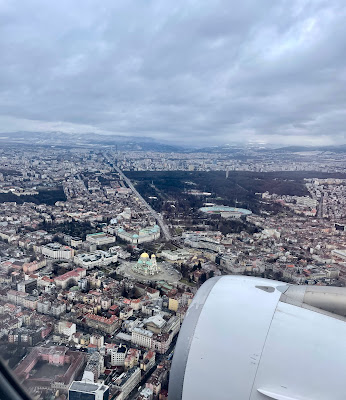Rila Monastery
Last weekend we ended our orientation with a trip to the Monastery of Saint Ivan of Rila. An hour bus ride led us to a building nestled in the frigid Rila Mountains, south of the capital Sofia. This monastery looks nothing like I had imagined. With intricate architecture and loud colors, I could tell the monastery rendered a mixture of cultures that channels Balkan culture.
Founded in the beginning of the 10th century and still standing as the largest Eastern Orthodox Monastery in Bulgaria, Rila Monastery is eye-catching with its massive domes, striped patterns, and detailed frescos.
Ivan of Rila, also known as Saint John of Rila, was the first Bulgarian hermit. He left his life as a monk to live in solitude in the caves of the Rila Mountains and devote his life to prayer. Students began to follow him and thus began the genesis of the monastery. After the Saint's death in 946 AD, his students built the monastery near the cave in which he lived. His relics were moved several times through the years, but now they are held in the church of the monastery where citizens come to pay their respects daily.
When Bulgaria fell under Ottoman rule at the end of the 14th century, the Monastery was vulnerable to attacks by the Turks and was eventually destroyed by a fire. Thanks to efforts from Bulgarians across the country, the revival of the Monastery began toward the end of the 15th century and now stands since the 19th century as the spiritual, cultural, and educational epicenter of Bulgaria.
More Facts
Nearly every square inch of the walls of the Monestary, both interior and exterior, are covered in elaborate frescos depicting religious scenes.
The heart of King Boris III (1894-1943) was buried in a grave inside the Monastery in 1994. He is the only King to be buried in the Monastery due in part to his refusal to Adolf Hitler when the dictator demanded the expulsion of 50,000 Bulgarian Jews.
Each day there are hundred of candles lit by worshippers inside the Monastery, illuminating the striking images and fixtures inside.
Julia Dick
References
“Boris III.” Encyclopædia Britannica, Encyclopædia Britannica, Inc., 2 Feb. 2007, https://www.britannica.com/biography/Boris-III.
“Rila Monastery – a Symbol of Bulgarian History.” Aparthotel Lucky Bansko SPA & Relax, Lucky Bankso, https://luckybansko.com/rila-monastery-a-symbol-of-bulgarian-history-p44553/.
“Rila Monastery.” Encyclopædia Britannica, Encyclopædia Britannica, Inc., 7 Apr. 2005, https://www.britannica.com/topic/Rila-Monastery.
“Rila Monastery.” UNESCO, UNESCO World Heritage Centre, https://whc.unesco.org/en/list/216/.
“St. Ivan of Rila.” RilaMonastery.info, https://www.rilamonastery.info/about-1/st-ivan-of-rila/.




Comments
Post a Comment